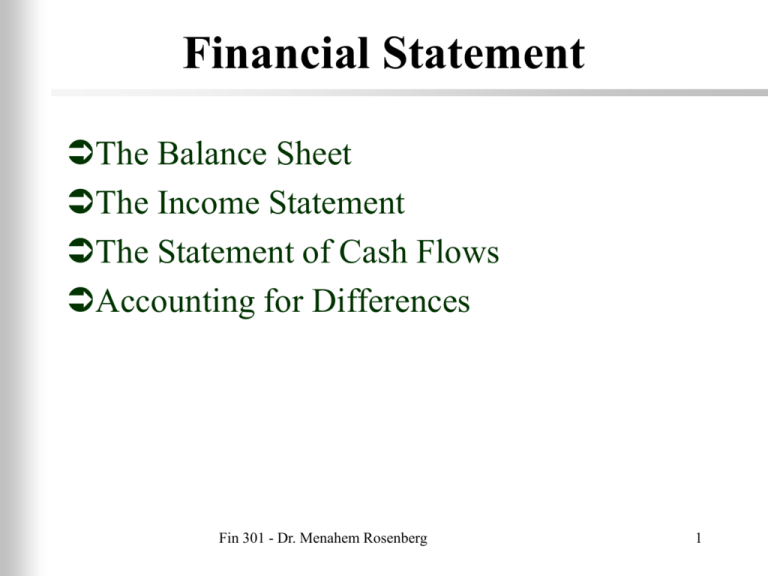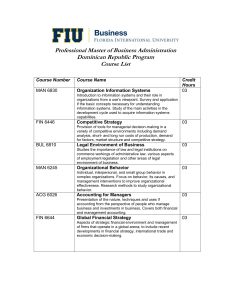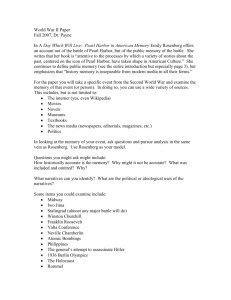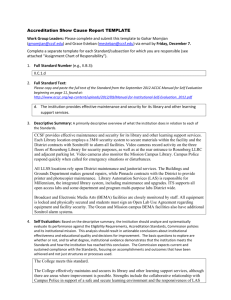Financial Statements
advertisement

Financial Statement The Balance Sheet The Income Statement The Statement of Cash Flows Accounting for Differences Fin 301 - Dr. Menahem Rosenberg 1 The Balance Sheet Definition Financial statements that show the value of the firm’s assets and liabilities at a particular point in time (from an accounting perspective). Fin 301 - Dr. Menahem Rosenberg 2 The Balance Sheet The Main Balance Sheet Items Current Liabilities Payables Accruals Short-term Debt Current Assets Cash & Securities Receivables Inventories + = Fixed Assets Tangible Assets Intangible Assets Fin 301 - Dr. Menahem Rosenberg + Long-term Liabilities + Shareholders’ Equity 3 Market Value vs. Book Value Book Values are determined by GAAP Market Values are determined by current values Equity and Asset “Market Values” are usually higher than their “Book Values” Fin 301 - Dr. Menahem Rosenberg 4 The Income Statement Definition Financial statement that shows the revenues, expenses, and net income of a firm over a period of time (from an accounting perspective). Fin 301 - Dr. Menahem Rosenberg 5 The Income Statement Earnings Before Income & Taxes (EBIT) EBIT = - total Revenues - costs - deprecation Fin 301 - Dr. Menahem Rosenberg 6 The Income Statement Timberland Co. Year End 12/31/2001- in thousands Revenue 1,183,623 COGS 662,848 SG&A 334,490 EBIT 186,285 Depreciation & Amortization Interest Expense Other income Average O/S shares 40,247 23,192 1,560 196 EBT 161,729 Tax Expense 54,988 Net Income 106,741 Fin 301 - Dr. Menahem Rosenberg 7 Profits vs. Cash Flows Differences “Profits” subtract depreciation (a non-cash expense) “Profits” ignore cash expenditures on new capital (the expense is capitalized) “Profits” record income and expenses at the time of sales, not when the cash exchanges actually occur “Profits” do not consider changes in working capital Fin 301 - Dr. Menahem Rosenberg 8 The Statement of Cash Flows Definition Financial statement that shows the firm’s cash receipts and cash payments over a period of time. Fin 301 - Dr. Menahem Rosenberg 9 The Statement of Cash Flows + Net Income + Non-cash expenses + Depreciation Changes in working capital - chg A/R +chg A/P -chg Inv = Cash Flow from Operations Cash from New Investments - purchases + sales Cash from Financing - repurchase of stock or debt + sales of stock or debt - dividend Net Change in Cash Position (from previous B/S to current) Fin 301 - Dr. Menahem Rosenberg 10 Accounting for Differences Subjective aspects exist in reporting earnings and book value Some liabilities may excluded from balance sheets (off balance sheet financing). International accounting standards vary Share outstanding in per share computations Fin 301 - Dr. Menahem Rosenberg 11 Leverage Ratios Long Term Debt Long Term Debt Ratio Long Term Debt Equity Long Term Debt Debt Equity Ratio Equity Total Liability Total Debt Ratio Total Assets EBIT Time Interest Earned Interest Expense Fin 301 - Dr. Menahem Rosenberg 12 Liquidity Ratios Net Workin g Capital Current Assets - Current Liab. Current Assets Current Ratio Current Liabilitie s Current Assets - Inventory Quick Ratio Current Liabilitie s Cash and Equivalent s Cash Ratio Current Liabilitie s Fin 301 - Dr. Menahem Rosenberg 13 Efficiency Ratios Sales Assets turnover Average Assets COGS Inventory turnover Average Inventory 365 Inventory Days Inventory Turnover Sales Receivable Days Average Receivable s/365 Fin 301 - Dr. Menahem Rosenberg 14 Profitability Ratios EBIT - Tax Net Profit Margin Sales EBIT - Tax Return on Assets (ROA) Average Total Assets NI avaiable to common equity Return on Equity Average common equity Dividend Payout Ratio NI Fin 301 - Dr. Menahem Rosenberg 15 Market Value Ratios NI available to equity Earning Per Share (EPS) Average O/S shares Stock Price Price Earning Ration PE Earning Per Share Dividend Per Share Dividend Yiels Stock price Book Value Total Assets - Total Liabilitie s Stock Price Market to BV per Share BV per Share Fin 301 - Dr. Menahem Rosenberg 16





